Chlamydomonas is a tiny, single-celled green algae you’d likely find in ponds, soil, or even damp tree bark. Imagine a microscopic organism shaped like a oval, sporting two whip-like tails called flagella that let it zip through water. What’s cool about it? Despite its simplicity, it’s a powerhouse in science. Researchers love studying it because it’s easy to grow and shares basic biological processes with more complex organisms, like how plants use sunlight to make energy through photosynthesis. Plus, it can reproduce in two ways—cloning itself or mixing genes with another cell—making it handy for genetics studies. Fun fact: Its ability to sense light with a tiny eye-like spot helps it navigate toward sunlight, like a solar-powered swimmer. This little alga might seem unassuming, but it’s taught us a lot about life’s building blocks.
What is Chlamydomonas?
- Commonly found in freshwater, moist soil, and snow-covered habitats, Chlamydomonas is a genus of unicellular, biflagellated green algae under the family Chlamydomonadaceae.
- In molecular biology, it is a model organism especially for investigations on photosynthesis, flagellar motility, and chloroplast dynamics.
- Greek is where the word “Chlamydomonas” comes from; “chlamys” signifies cloak and “monas” reflects its unicellular character.
- Through the study of Franz Moewus, who investigated its sexuality and genetics, Chlamydomonas first became well-known in the 1930s; although his conclusions were later questioned,
- Usually spherical to cylindrical, Chlamydomonas cells have two anterior flagella for motility, a cup-shaped chloroplast with a pyrenoid for starch synthesis, and an eyespot for light perception.
- Unlike the cellulose-based walls of many other algae, the cell wall consists of glycoproteins and non-cellulosic polysaccharides.
- Chlamydomonas sexually and asexually reproduces. Depending on the species, sexual reproduction can be isogamous, anisogamous, or oogamous; asexual reproduction proceeds via zoospores, aplanospores, or hypnospores.
- During its life cycle, the zygote develops a thick-walled zygospore that meiosis upon germination produces haploid cells that grow into adult people.
- Ecologically, Chlamydomonas is essential as a main producer in aquatic environments as it generates oxygen and provides food for other species.
- Some species, such as Chlamydomonas reinhardtii, present opportunities for renewable energy sources as their possible biohydrogen generation under particular conditions has been investigated.
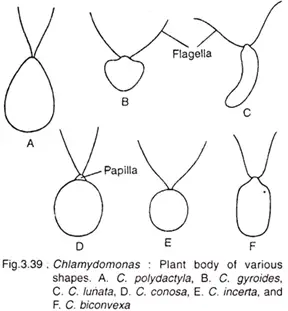
Chlamydomonas Classification
Chlamydomonas is a genus of unicellular green algae widely studied for its significance in photosynthesis, genetics, and cellular motility.
The taxonomic classification of Chlamydomonas is as follows:
- Domain: Eukaryota
- Kingdom: Plantae
- Phylum: Chlorophyta
- Class: Chlorophyceae
- Order: Chlamydomonadales
- Family: Chlamydomonadaceae
- Genus: Chlamydomonas
- Species: Various, including Chlamydomonas reinhardtii, a model organism in molecular biology.
Members of the genus Chlamydomonas are characterized by their biflagellate structure, cup-shaped chloroplasts, and the presence of an eyespot apparatus that facilitates phototaxis.
The genus comprises approximately 150 species, inhabiting diverse environments such as freshwater, seawater, damp soil, and even snowfields.
Chlamydomonas species exhibit both asexual and sexual reproduction, with mechanisms including isogamy, anisogamy, and oogamy, depending on the species and environmental conditions.
| Clade: | Viridiplantae |
| Division: | Chlorophyta |
| Class: | Chlorophyceae |
| Order: | Chlamydomonadales |
| Family: | Chlamydomonadaceae |
| Genus: | Chlamydomonas |
Habitat of Chlamydomonas
Chlamydomonas is a worldwide genus of unicellular green algae with 400 to 500 species and a diverse variety of environments.
It mostly lives in freshwater settings such as lakes, ponds, ditches, pools, water tanks, and slow-moving streams, particularly those high in nitrogenous chemicals and organic waste.
Terrestrial species are often found in damp, moist soils, such as forest floors and wet rocks.
Certain species, such as Chlamydomonas nivalis, flourish in alpine and arctic environments, growing on snow and imparting a red colour due to the presence of the red pigment haematochrome.
Some species, such as Chlamydomonas yellowstonensis, thrive in severe settings, including geothermal sites like Yellowstone National Park, where they contribute to the yellow-green colouration of snow.
Chlamydomonas species may be found in brackish and saline waters, with examples being C. halophila and C. ehrenbergii.
In addition, some species fly, showing their existence in aerial environments.
The genus is remarkably adaptable, colonising a wide range of habitats, from freshwater and marine settings to snowfields and wet terrestrial locales.
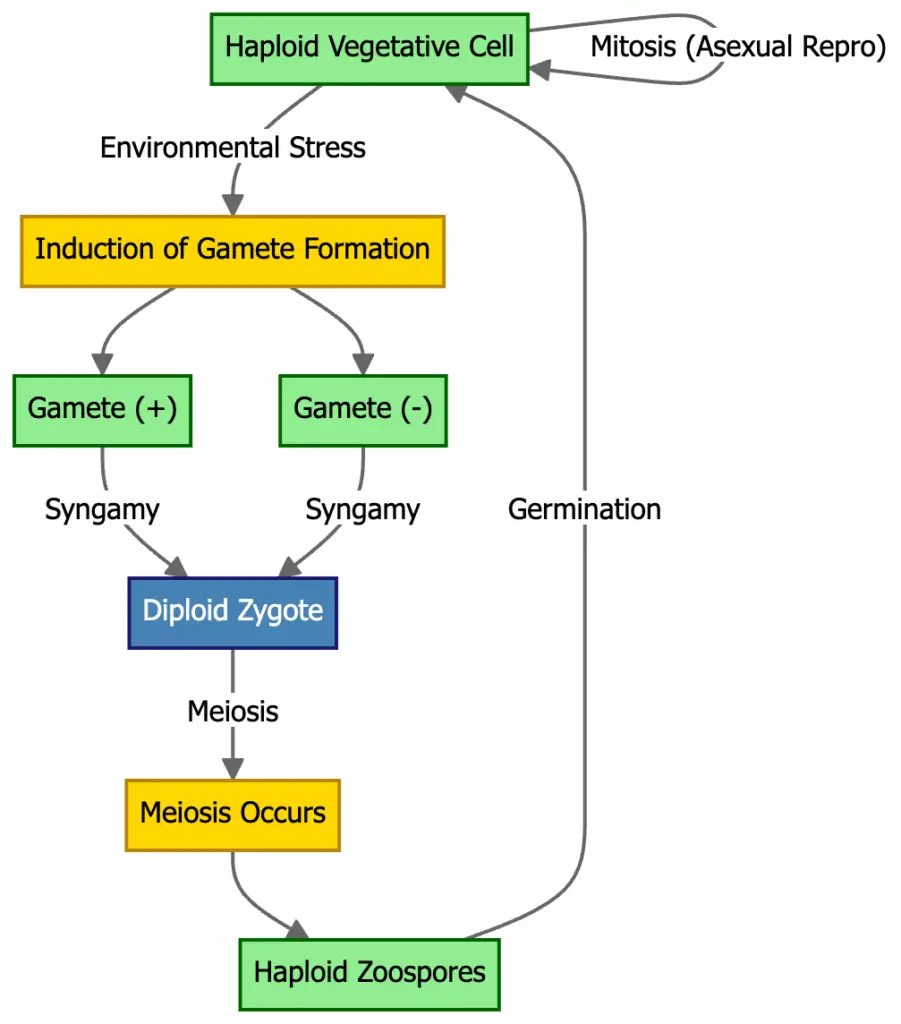
Nutrition of Chlamydomonas
Three main forms of nutrition are shown by chlamydomonas: autotrophic, heterotrophic, and mixotrophic, which helps it to fit different environmental circumstances.
Under autotrophic feeding, Chlamydomonas uses light energy via photosynthesis to synthesis organic molecules from inorganic sources. Under light-rich environments, this mode is mostly dominant.
Under heterotrophic feeding, Chlamydomonas makes use of organic molecules from the surroundings, such acetate or glucose, in the lack of light. The organism’s capacity to absorb and process outside organic compounds helps this mode to be enabled.
Combining autotrophic and heterotrophic processes, mixotrophic nutrition lets Chlamydomonas concurrently absorb organic molecules and photosynthesise. Under changing climatic circumstances notably, this dual approach improves biomass accumulation and rates of growth.
Chlamydomonas’s capacity to alternate between several nutritional modes gives it a competitive edge in many environments, which helps to explain its great ecological success and range.
Characteristics of Chlamydomonas
- The genus Chlamydomonas is unicellular green algae of the family Chlamydomonadaceae.
- Usually oval or pear-shaped, the cells have a diamension of 10–20 µm.
- Two flagella found at the front end of every cell help to enable movement over water.
- Without cellulose, glycoproteins high in hydroxyproline make up the cell wall.
- Mostly occupying the cytoplasm, a big, cup-shaped chloroplast stores starch using a single big pyrenoid.
- Embedded within the chloroplast, an eyespot—stigma—a light-sensitive organelle helps to promote phototaxis.
- Chlamydomonas displays both asexual reproduction via zoospores and sexual reproduction by many processes, including oogamy, anisogamy, and isogamy.
- In study, it is a model organism that helps investigations on photosynthesis, flagellar action, and cellular reactions to environmental cues.
- Found in a variety of environments including freshwater ponds, moist soils, and snowfields, chlamydomonas species show adaptation to several environmental circumstances.
Structure of Chlamydomonas/Thallus Structure of Chlamydomonas
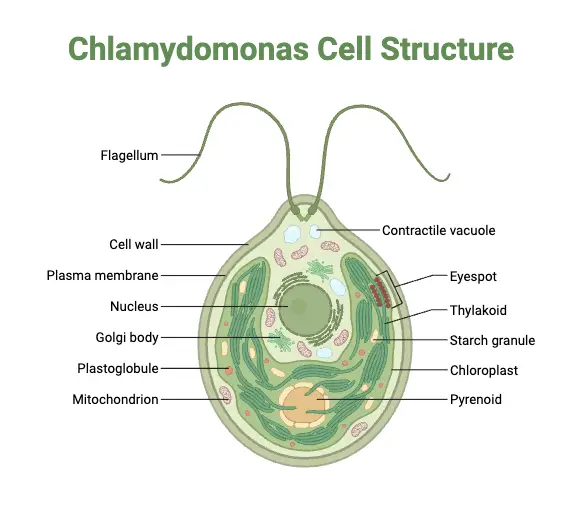
- Chlamydomonas thallus is unicellular, motile, and biflagellate, with a green colour attributable to chlorophyll pigments.
- Cell shapes vary per species, and might be spherical, ellipsoidal, oval, oblong, or pyriform. Cells typically measure 20 to 30 μm in length. The anterior end is usually pointed and ends in an apical papilla, whereas the posterior end is wider.
- The cell wall is smooth and thin, made largely of cellulose. In certain species, such as C. gleocystiformis, a gelatinous pectin layer covers the cell wall, generating a beak-shaped apical papilla at the anterior end. The wall is multilayered with cellulose fibrils and encloses a semipermeable plasma membrane.
- The cytoplasm houses important organelles such as a single big nucleus, mitochondria, endoplasmic reticulum, dictyosomes (Golgi bodies), and ribosomes. The nucleus is suspended inside the cup-shaped chloroplast. Ribosomes in the cytoplasm are 80S, whereas chloroplasts have 70S ribosomes.
- A conspicuous, cup-shaped chloroplast fills a major section of the cell and varies in form across species (e.g., H-shaped in C. bicilliata and reticulate in C. reticulata). The chloroplast includes one or more pyrenoids, which serve as starch synthesis centres. The chloroplast structure consists of a double membrane envelope with interior lamellae that form grana and a stroma containing DNA, ribosomes, and microtubules.
- An eyespot or stigma on the front side of the chloroplast serves as a photoreceptive organ. It consists of a pigmented plate (pigmentosa) and a biconvex lens, which aids in phototactic movement by sensing light intensity and direction.
- Two equal-length whiplash flagella arise from the front end to aid in movement. Each flagellum grows from a basal granule (blepharoplast) and has a 9+2 arrangement of microtubules. The flagella arise from tiny channels in the cell wall.
- In certain species, such as C. nasuta, a neuromotor apparatus exists, comprising of two basal granules joined by a paradesmos fibre and linked to the nucleus by a rhizoplast. This structure regulates flagellar movement in response to stimuli.
- Typically, two contractile vacuoles are seen around the base of the flagella. These vacuoles maintain osmotic equilibrium by removing excess water from the cell.
Life Cycle of Chlamydomonas
The reproduction in Chlamydomonas is both asexual and sexual.
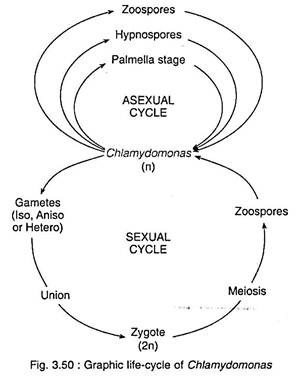
Asexual Reproduction
Mostly by zoospore development, but also via aplanospores, hypnospores, the palmella stage, and synzoospores, chlamydomonas reproduces asexually via several ways.
- Zoospores – Usually at night, zoospore production takes place under ideal conditions. The parent cell loses its contractile vacuoles and its flagella. Usually generating eight daughter protoplasts, the protoplast withdraws slightly from the cell wall and undergoes successive longitudinal mitotic divisions; the count can vary. Every daughter protoplast develops a cell wall and, upon release from the parent cell, creates flagella, thereby transforming motile zoospores able to produce new individuals.
- Aplanospores – Unfavourable circumstances lead to aplanospores. Protoplast divisions of the parent cell produce 2–16 daughter protoplasts, each secreting a thin wall but not moving. When circumstances are favourable, planospores can either divide further to produce zoospores or develop straight into new cells.
- Hypnospores – Under extreme negative circumstances, like a drought, hypnospores—thin-walled, non-motile spores—form. Though their wall is more strong, their shape is like that of aplanospores. Under suitable conditions, hypnospores germinate either directly into new cells or by means of further protoplast divisions.
- Palmella Stage – The palmella stage is when environmental circumstances abruptly turn bad during zoospore development. The parent cell wall gelatinises, and the daughter protoplasts likewise get buried in a mucilaginous matrix to create a non-motile colony looking like the alga Palmella. The attached cells become individual zoospores when the conditions are appropriate.
- Synzoospore – Under artificial culture, synzoospores—multinucleate, multicoloured flagellate zoospores—are seen. They arise when the nucleus of the parent cell splits into many nuclei, each growing a pair of flagella, producing a compound zoospore.
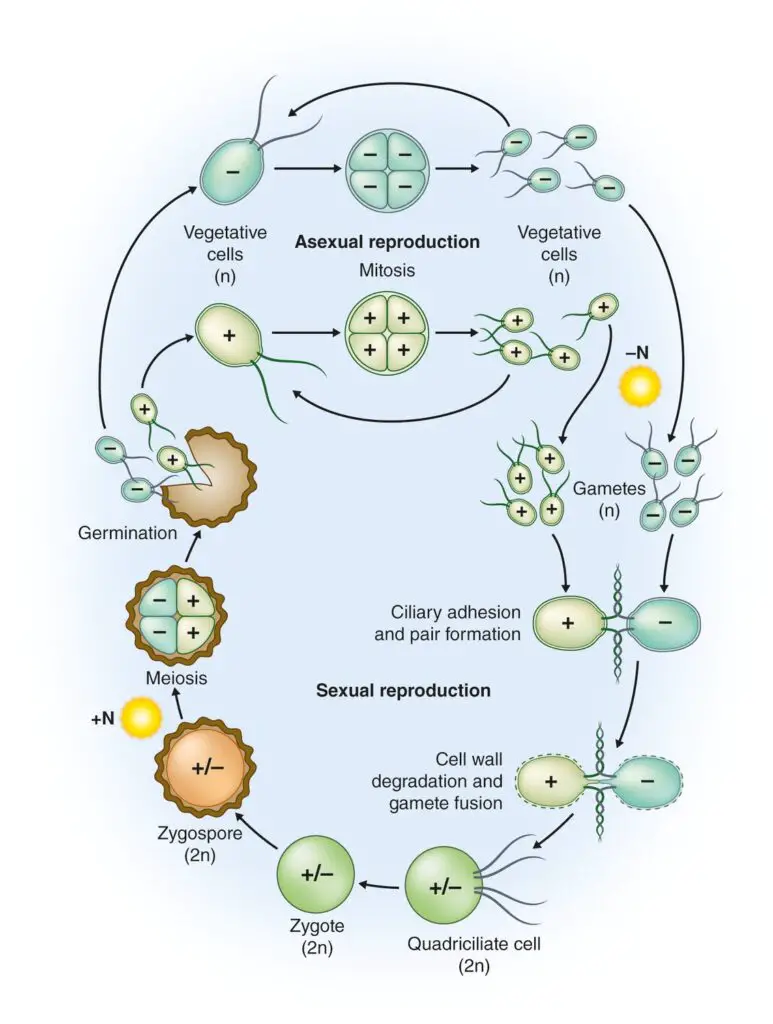
Sexual Reproduction
Chlamydomonas engages in sexual reproduction chiefly during environmental stressors, like desiccation or nitrogen scarcity, utilising processes such as isogamy, anisogamy, and oogamy.
- Isogamy – Isogamy entails the fusing of physically similar yet physiologically different gametes. In certain species, vegetative cells directly convert into gametes (hologamy), but in others, they undergo division to yield 8 to 64 gametes. Gametes can arise from a single individual (homothallic) or from distinct people (heterothallic). During fusion, gametes identify one another by agglutin, a protein covering their flagella, enabling the development of a quadriflagellate zygote through plasmogamy followed by karyogamy.
- Anisogamy – Anisogamy is defined by the amalgamation of heterogeneous gametes: bigger, less mobile macrogametes (female) and smaller, more mobile microgametes (male). Generally, female gametangia generate 2 or 4 macrogametes, whereas male gametangia provide 8 or 16 microgametes. Fusion produces a diploid zygote.
- Oogamy – Oogamy involves the amalgamation of a large, non-motile macrogamete (female) with a diminutive, motile microgamete (male). The male gametangium undergoes division to produce several microgametes, while the female cell transforms into a macrogamete by discarding its flagella. The motile male gamete adheres to the anterior region of the macrogamete, resulting in zygote development.
- Zygote – Subsequent to fertilisation, the zygote initially retains motility, preserving its flagella for a varied duration. Thereafter, it settles, sheds its flagella, and forms a robust, decorated wall, evolving into a zygospore. The zygospore stores carbohydrates and oil, functioning as energy reserves.
- Germination of Zygote – Upon germination, the diploid nucleus of the zygospore undergoes meiosis, yielding 4 to 32 haploid nuclei, contingent upon the species. These haploid cells are expelled following the disintegration of the inner wall and the rupture of the outer wall, each generating flagella and operating as independent entities.
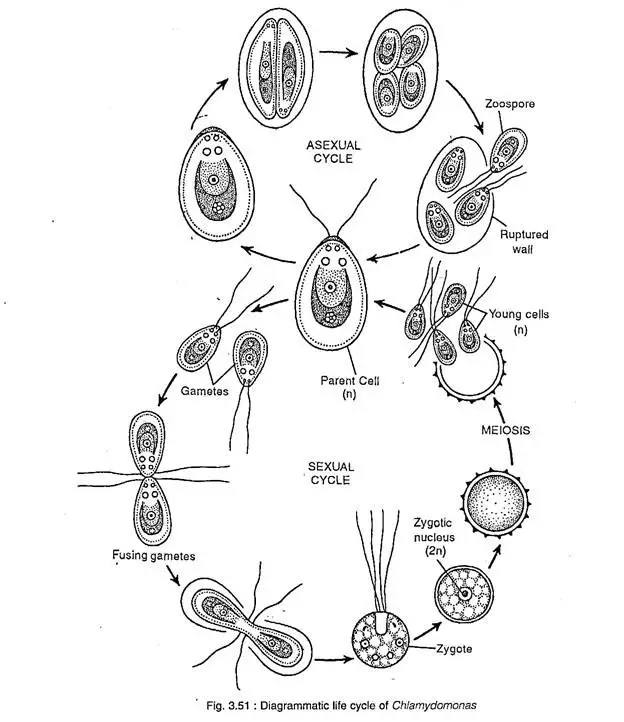
Genome Structure of Chlamydomonas
- Chlamydomonas reinhardtii has a tripartite genome structure that includes nuclear, chloroplast, and mitochondrial genomes, each exhibiting unique properties.
- The nuclear genome is haploid, with 17 chromosomes and encompassing around 111 to 120 megabase pairs (Mb). It demonstrates a substantial guanine-cytosine (G+C) concentration of around 64%.
- The nuclear genome contains around 14,000 protein-coding genes, with estimations of up to 19,500 transcripts when accounting for splice variants.
- The chloroplast genome is a circular DNA molecule of approximately 203.8 kilobase pairs (kb) and possesses a G+C content of 35%. It encodes 99 genes, including those critical for photosynthesis and chloroplast functioning.
- The mitochondrial genome is linear, roughly 15.8 kilobases in length, with a G+C composition of around 45%. It encodes thirteen genes and is devoid of introns.
- Advancements in sequencing technologies, including PacBio and Oxford Nanopore, have resulted in highly contiguous genome assemblies, enhancing the comprehension of genome structure and function.
- The accessibility of extensive genomic data has advanced research in fields like as photosynthesis, cilia functionality, and biofuel generation, positioning C. reinhardtii as a model organism in molecular biology.
Examples of Chlamydomonas
Chlamydomonas is a genus of green algae comprising over 500 species, with approximately 150 species described globally .
Some notable species of Chlamydomonas include:
- Chlamydomonas reinhardtii: A widely studied model organism in molecular biology and genetics. It is haploid and can grow on simple inorganic media using photosynthesis or acetate as a carbon source .
- Chlamydomonas nivalis: Known for causing “watermelon snow” due to its red pigment, hematochrome. It thrives in snowfields of polar and alpine regions .
- Chlamydomonas moewusii: A species exhibiting anisogamy, where gametes differ in size and motility. It has been studied for its sexual reproduction mechanisms .
- Chlamydomonas caudata: Characterized by its elongated shape and motility, commonly found in freshwater environments.
- Chlamydomonas globosa: A spherical species often found in stagnant water bodies.
- Chlamydomonas subcaudata: Noted for its tail-like extension and motility in aquatic habitats.
- Chlamydomonas yellowstonensis: Imparts a yellow-green color to snow in Yellowstone National Park .
- Chlamydomonas halophila: Adapted to saline environments, commonly found in brackish waters .
- Chlamydomonas ehrenbergii: Another species thriving in saline conditions, contributing to the diversity of Chlamydomonas in various habitats.
Examples of Indian Species of Chlamydomonas
Chlamydomonas is a genus of green algae with approximately 500 species described globally.
In India, around 18 species of Chlamydomonas have been reported.
Some of the common species found in India include:
- Chlamydomonas moewusii
- Chlamydomonas monadina
- Chlamydomonas subcaudata
- Chlamydomonas grandistigma
- Chlamydomonas iyengarii
- Chlamydomonas caudata
- Chlamydomonas ehrenbergii
- Chlamydomonas snowiae
- Chlamydomonas yellowstonesis
Fresh and stationary water sources like ponds, pools, lakes, and wet soil surfaces mostly house these species.
In water bodies, certain species—like Chlamydomonas intermedia—have been noted to show positive connection with dissolved oxygen and negative correlation with dissolved organic matter.
With species found in freshwater ponds, lakes, sewage ponds, marine and brackish waters, snow, garden and agricultural soil, forests, deserts, peat bogs, damp walls, sap on wounded trees, artificial ponds, and even on roof tiles, the genus Chlamydomonas is rather extensively distributed in India.
Because of their part in primary production and as bioindicators of water quality, these species are valuable in ecological research.
Chlamydomonas under microscope
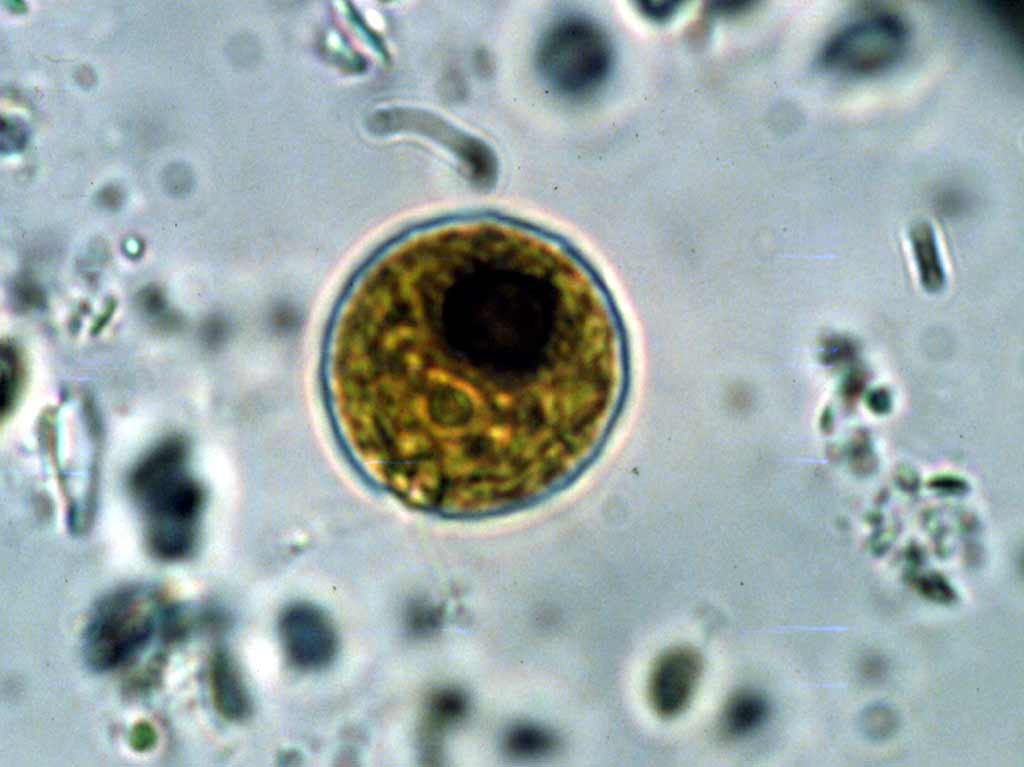
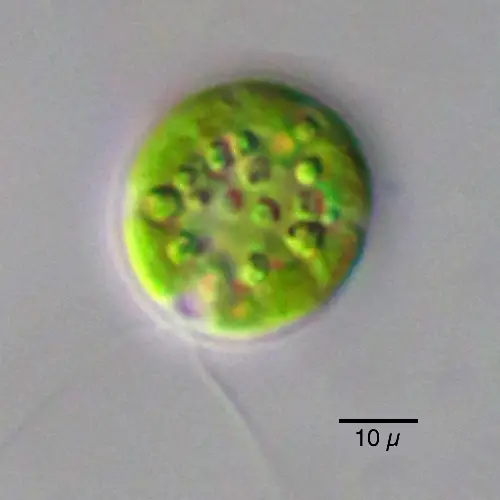
- Huang, B. P.-H. (1986). Chlamydomonas reinhardtii: A Model System for the Genetic Analysis of Flagellar Structure and Motility. Molecular Approaches to the Study of Protozoan Cells, 181–215. doi:10.1016/s0074-7696(08)61427-8
- Severin Sasso, Herwig Stibor, Maria Mittag, Arthur R Grossman (2018) The Natural History of Model Organisms: From molecular manipulation of domesticated Chlamydomonas reinhardtii to survival in nature eLife 7:e39233.
- Patrice A. Salomé, Sabeeha S. Merchant, A Series of Fortunate Events: Introducing Chlamydomonas as a Reference Organism, The Plant Cell, Volume 31, Issue 8, August 2019, Pages 1682–1707, https://doi.org/10.1105/tpc.18.00952
- https://warbletoncouncil.org/chlamydomonas-3442
- https://biologylearner.com/chlamydomonas-salient-features-occurrence-thallus-structure-reproduction/
- https://www.scienceneo.com/biology/diversity/plantae/chlamydomonas/
- https://www.cell.com/current-biology/abstract/S0960-9822(24)00682-1
- https://www.vedantu.com/biology/chlamydomonas
- https://www.biologydiscussion.com/algae/chlamydomonas-occurrence-features-and-life-history/46847
- https://www.w3.org/WAI/tutorials/images/decision-tree/
- https://www.geeksforgeeks.org/chlamydomonas/
- https://en.wikipedia.org/wiki/Chlamydomonas
- https://www.biologydiscussion.com/algae/life-cycle-algae/chlamydomonas-position-occurrence-and-structure-with-diagrams/21052
- https://entechonline.com/chlamydomonas-taxonomy-and-classification-in-depth-analysis/
- https://biologyinsights.com/c-reinhardtii-a-cornerstone-of-algal-research/
- https://www.biologydiscussion.com/algae/life-cycle-of-chlamydomonas-with-diagram/53699
- Text Highlighting: Select any text in the post content to highlight it
- Text Annotation: Select text and add comments with annotations
- Comment Management: Edit or delete your own comments
- Highlight Management: Remove your own highlights
How to use: Simply select any text in the post content above, and you'll see annotation options. Login here or create an account to get started.